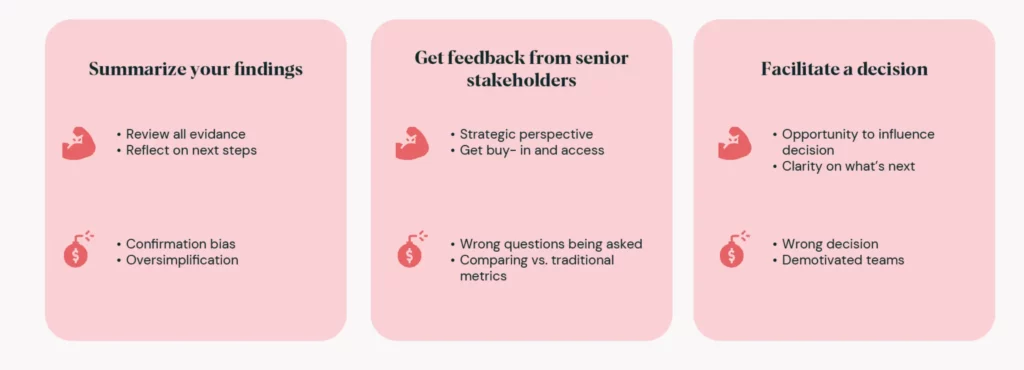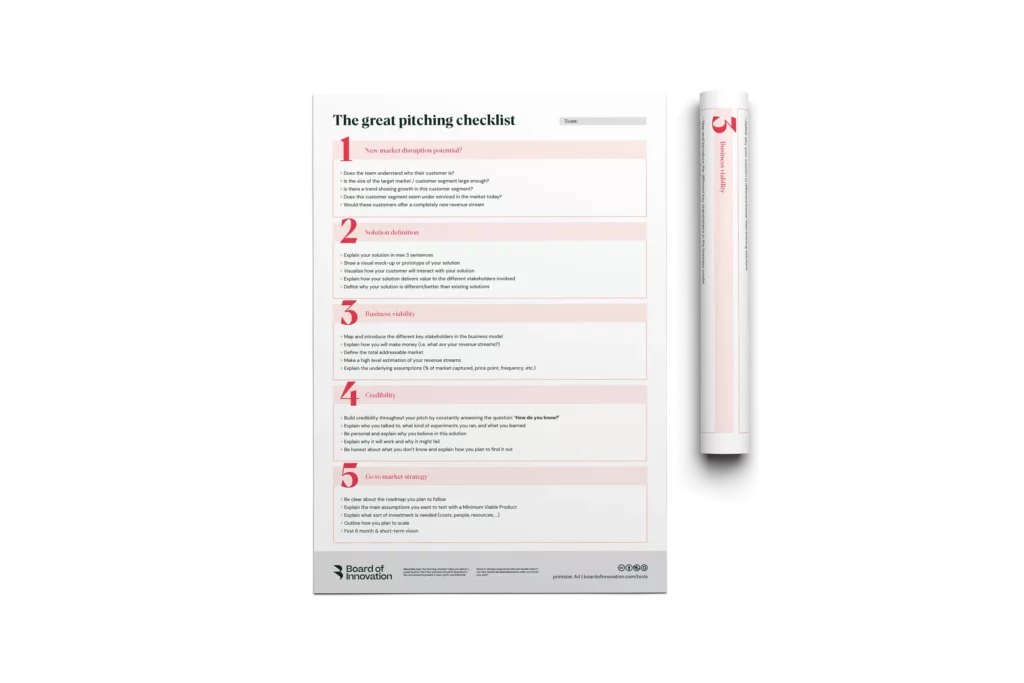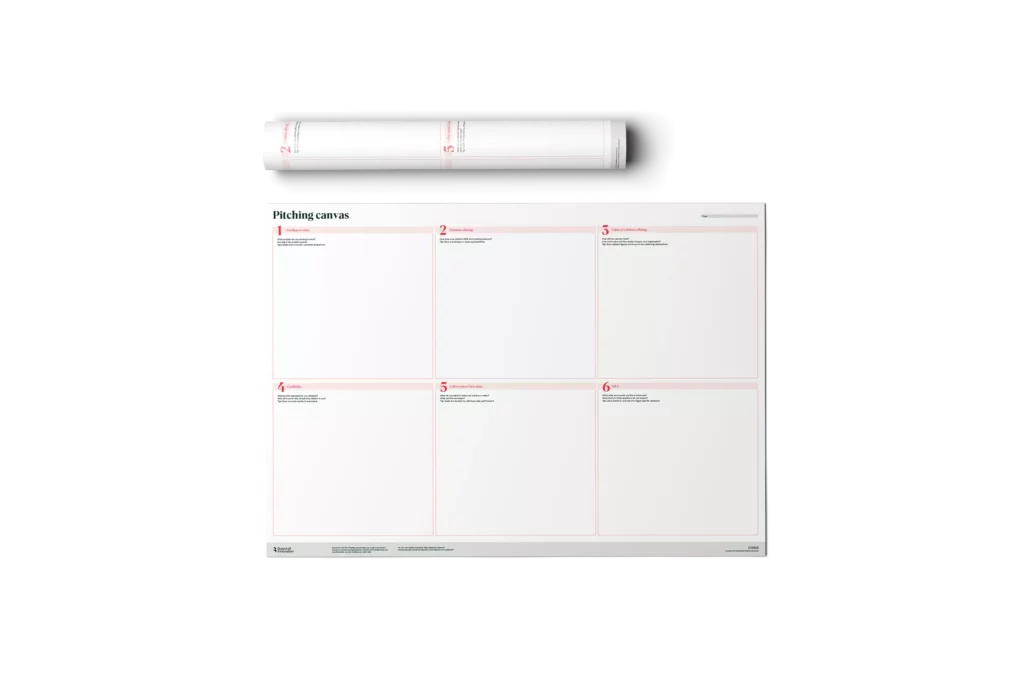Whether you’ve been through a design sprint, an innovation strategy track, or corporate accelerator, the finish line is the pitch. It is the moment your innovative efforts get the “go” or “no go”. Too often, we see “meh” projects given the green light, and awesome ideas get the thumbs down. Pitching successfully is one way to make sure the best ideas aren’t passed over in favor of a mediocre one that gets the nod because of a slick presentation.
The purpose of the pitch
Pitching is about getting feedback about the business idea you’ve been creating. This is the moment you sum up your findings to show what you’ve learned, and present the outcome of the project in concrete terms. It is designed to decide which projects are going forward — and why — and which ones are being shelved — and why. Your job when pitching is to show that the business idea your team has come up with has measurable added value for the company, and to express that in a way that aligns with senior management objectives and the company strategy.

Summarize your findings
Do
Concisely present all the evidence you have gathered. The key thing here is to show that what you are saying is based on validated learnings. The most important question in any pitch is “How do you know?”. Make sure you answer this question for the jury, but don’t make their heads heavy by bombarding them with information or an overload of figures. Results of experiments should be used to show only what is necessary to highlight the point that you want to get across. We’re not saying you should gloss over facts. Rather, be to-the-point and save the detailed breakdown for the Q&A.
The pitch should be a way to show that you are 100% ready for what comes next. You have a prototype, a business model and a strong case for going forward, but you want to show that you have a plan of action after the pitch. A winning pitch is not the end — you must answer the “then what?”. Having a clear idea of the next phase of the journey and how you’re going to tackle it assures investors that you can take it from there.
Dont
It is possible to fall into the trap of making a “my side” pitch that backs up what you know and believe, overlooking crucial information about your idea. Innovators beware: the tendency to search for, interpret and share information that supports your hypothesis can be strong when you are passionate about your business idea. This bias can blindside a team during the pitching phase. Remember the inductive reasoning argument “my daddy’s better than your daddy”? This is the slightly more sophisticated grownup version.
‘Keep it simple, Stupid’ is a speechwriting tip that should be taken with a grain of salt. You’re dealing with executives, not the lowest common denominator. Making an idea comprehensive shouldn’t be at the expense of dumbing it down. Avoid making it “as simple as 1,2,3” or showing how quick and easy something can be. Aim to make it short and sweet, not nice and pretty.

Get feedback from senior stakeholders
Do
Your pitch should keep the investors’ perspective in mind. Senior management thinks in terms of bottom lines, market trends, and the future vision of the company. They are in charge of leading the company forward. Your business idea needs to reach them on that level and speak to their concerns. Talk to them beforehand or research the company strategy to know who and what you’re dealing with.
To get buy-in you need to put money where your mouth is. The panel of investors should feel that you would personally invest in your idea if the money were yours to spend. They want to see that your project is ready to launch and scale. That’s big money and they don’t want to be out of pocket. Buy-in is confirmation that you’re on the right track and that the powers that be trust that you can deliver.
Dont
Stakeholders often ask the wrong questions during a pitch. For example, they might ask what the return on investment (RoI) is going to be. Those aren’t things that you should (or need to) know yet, so avoid trying to work them into your pitch to keep the jury happy. Show them that there is a problem and how you are going to fix it, and convince them that thinking about RoI is getting away from the task at hand. In an ideal world, the jury should have received a short training on which questions to ask and, more importantly, which ones not to ask. If they didn’t, don’t be afraid to step up and educate them.
Similar to the above, senior management often thinks only as far as the projects the company has done or status quo products and services that fit with the typical way of working. The aim is to get them out of the business-as-usual approach. They should be focused on comparing innovative business ideas with each other, rather than the same-old, same-old.
Here are some pitching tools to help you both craft and refine your pitches:

Pitching checklist
- Challenge your draft
- Key questions on problem, solution, business model, validation and call to action
Designing the perfect pitch
Do
Walk the panel of senior managers through the process from problem to call to action. Start with the customer pain points and the validated user problem you are trying to solve. This shows you’ve done your customer interviews and considered all aspects of addressing them through iteration and experimentation. Demonstrate that the solution is not only desirable and viable, but feasible. You do this by showing that you have a solid business model that strongly supports the business idea. The call to action should be clear and well-defined: What is the purpose going forward?

Dont
- What problem are we aiming to solve?
- How does it impact the problem owner?
- How are we proposing to solve the problem?
- How feasible is the solution we have in mind?
- How will we capture value? From whom?
- How much value will this generate for the organization?
- What are our assumptions about desirability, viability & feasibility?
- How have we validated those assumptions? What kind of experiments did we run?
- What do we need to make our solution a reality?
- What should the next steps be?
In the words of esteemed public speaking coach, David JP Philips: Avoid death by PowerPoint presentation.
Our three rules for presenting
Don’t have any more than three messages per slide. Any more is overkill and people begin to read rather than listen, and that’s when you can lose your audience.
Do include visuals. Use them to support the message. One slide of text with three sentences on it is better broken up into three separate slides with one sentence each. Give out information in chunks, not all at once. That way people are more likely to remember it. Images are powerful ways to get across emotions and feelings. Browse Unsplash for a beautiful gallery of free images.
Do provide structure. It’s great to have a table of contents to provide an outline at the very beginning. Use visual cues to show where you are through the process. And repeat key messages multiple times so that they stick.

Delivering the perfect pitch
Pitching is about walking the executive panel through what you know and getting them to see it through your eyes. It’s not a presentation. It’s a journey. It should change people. Ultimately, you want them to learn something, have their eyes opened, or their perspectives shifted. You achieve this through the right flow. Just like perfect pitch in music, it’s about hitting the right tone right off the bat.
Keeping the dynamics high during the pitch helps ensure your business idea is positively received by the jury. The way to wow them is to leave them on an up note. But that is best done by starting at a low point: the user problem. Make them feel the user’s frustration as if it were their own. You’ve walked a mile in your customer’s shoes during the empathy phase of your customer research — now it’s time to translate that for senior management. Then, when you get to the solution phase, they are more invested in the outcome and knowing how you resolved the problem. Don’t spend too long on the problem, just enough to give you a jumping off point for the solution.

Tip: Make sure each slide answers a question triggered by the previous slide.
Here are some final ‘tips and tricks’ takeaways to keep in the back of your mind when presenting. Following them will help with flow, dynamics, and setting the right atmosphere:
Do's
- Be relaxed
- Be personal
- Be positive
- Be clear
- Be ready
- Be selective
Don'ts
- Don’t apologize
- Don’t stand in one place
- Don’t fool around
- Don’t overshoot for time
- Don’t fade out
Q&A: Crunch time
This is moment of truth, when everything you’ve put together is put to the test. View the Q&A moment as a chance to shine even more than you did in your pitch. In fact, if done right, the Q&A should be longer than your pitch by almost double the amount of time. If you create the sort of pitch that leaves people wanting to know more — not because they are confused or left hanging, but because they are curious and have specific questions — then the Q&A is when you cement their trust in your capabilities. Because you are now familiar with being outside your comfort zone, you should now be comfortable with unknown. That doesn’t mean you shouldn’t have well-researched and rehearsed answers at hand, simply that you can respond with both grace and calculated precision to the ones that come out of the blue.
Tip: Practice your answers by using this great VC question generator tool.

Free Webinar
We believe that the best business idea should result in stakeholder buy-in. Here are some of our best-pratices to do a perfect pitch



